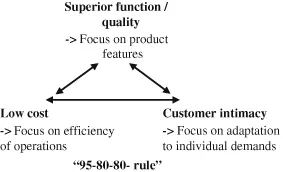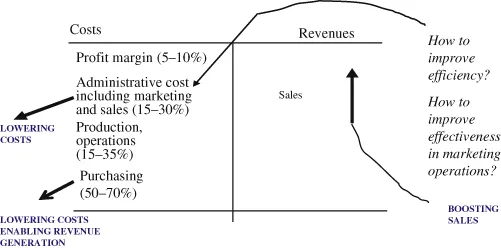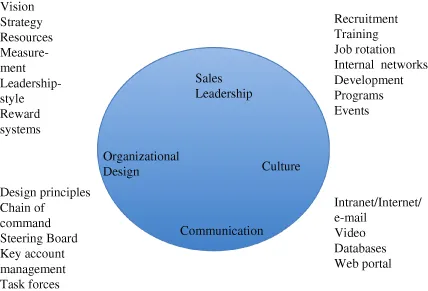![]()
Part I
Introduction: Organizing Marketing and Sales
This part consists of three chapters addressing the following three broad questions:
- (1) The first question is “what is going on in contemporary business practices?” We address this by providing some observations of ongoing B2B sales and marketing practices (Chapter 1).
- (2) The second question is “what does it really mean to manage sales and marketing in practice?” Here we bring in a thick description from a real-world multinational operation to demonstrate the multitude of, often conflicting, requirements and tensions that needs to be addressed in many sales and marketing organizations (Chapter 2).
- (3) The third question is “which are the generalized developments over time?” This is addressed by a researcher view, based on extant research of overall sales and marketing challenges in the past, present, and future (Chapter 3).
![]()
Chapter 1
Contemporary Developments and Challenges in Sales Organizations: Some Observations
Björn Axelsson
Abstract
The purpose of this chapter is to set the stage for the rest of the book. It is based on a number of interesting observations illustrating contemporary activities in regard to a broad range of sales-related topics. Among other observations are a number of developments that have followed with digitalization.
The chapter presents the core themes of the book and provides rationales for the choices. The themes are: value-based offerings, solution-oriented business, and on-going efforts of organizing to manage the multitude of issues connected to sales and marketing.
A second issue is the presentation of a framework against which to position important core issues in sales management. This includes aspects of organizational design, leadership, technology support, and more. All these are organized into four main categories. This “map” is utilized to position the coming parts and chapters.
Keywords Value creation; sales leadership; organizational design; information system tools; service orientation
Introduction
During the last decade, marketing and sales in business-to-business (B2B) contexts has got renewed attention in business world. Some key concerns, such as how to deal with the interplay — or conflict — between the roles of marketing and sales, have long been at issue but are more frequently discussed from a different perspective in the current climate. Similarly, other aspects — such as the management and motivation of the sales force as well as selecting, motivating, and training people in the sales force — have also always been on the table for discussion but seem to be addressed differently in contemporary business. The view of what constitutes a sales process in contemporary business has also been put in to question. The old “7 Steps of Selling” has been challenged from various angles (Moncrief & Marshall, 2005).
We could think of many reasons for such changes to take place. Technological development has introduced new tools, like customer relationship management (CRM) systems and marketing through the web, which dramatically change the prerequisites for sales-force operations. Competition has changed in character, forcing many companies to try to differentiate by, for example, trying to move toward more integrated, solutions-based market offerings. This is but one important force changing the view of marketing and sales. Another factor that changes the landscape is that B2B customers in general have put increased efforts into strengthening their procurement operations, thus making them more strategic. There are mirroring effects on the sales and marketing side.
The indicated developments are only illustrations. There are many more challenges as well as new opportunities in today’s sales operations. Though novel developments are increasingly common, one thing has not changed. Nothing seems to slow down the on-going efforts to make sales and marketing divisions more efficient and more effective. Getting the job done spending as little time and resources as possible and receiving as much sales activity as possible in return for the resources spent. At the same time, organizations want sales and marketing to create more value, do more business, sell more profitable solutions, bring in more profitable customers, etc. Though the observations addressed in this chapter, indeed in this entire book, are on all of these factors, two themes stand out:
- (1) Value creation seems to be the goal in managing almost all the problems we examine. We will say some more about this in the following section.
- (2) Organizational means tend to dominate the focus of managerial attention when meeting challenges during the organizational process.
In the rest of this introductory chapter, we will demonstrate how some of the new opportunities have become manifested in selected business firms. In Chapter 3, we provide a more theory-based and principal discussion on ways to organize in order to manage these challenges.
Value Creation in Contemporary B2B Business
Marketing, especially in B2B contexts, is sometimes defined as the art of understanding, creating, and delivering value (Anderson, Narus, & Narayandas, 2008). Value is determined by customers and is evaluated relative to alternative solutions or providers. Anderson et al. (2008) also emphasize, in line with so-called service dominant logic (SDL), that value should primarily be considered when “in use,” i.e., the impact it may have on the customer’s operations. In Axelsson et al. (2005, see also discussion in Chapter 4 of this book), value in operations is divided into three main categories:
- (1) Lower costs of the products and services needed — this could be due to lower prices of input material and services, a different mix of items procured, lowered transactions costs, etc.
- (2) Improved utilization of production means: machinery, facilities, personnel.
- (3) Increased revenues.
In line with the idea of departing from value for the customer, Treacy and Wiersmaa (1997) already developed a framework for elaborating various value-based business strategies. They found that firms that proved to have enduring profitability acted according to one of three so-called value disciplines. Figure 1.1 is a way to illustrate these and how they relate.
Figure 1.1: Three Value Disciplines. Source: Own construction.
The first of those three value disciplines a firm can exercise is being excellent in offering goods or services at low costs. In order to do that, a firm must excel in operations efficiency and, thus, build relevant capabilities for that discipline.
The second value discipline a firm can exhibit is being excellent in offering a superior service, i.e., being a product leader. This would call for different kinds of capabilities than the first value discipline.
Finally, the third value discipline demands a firm to orient toward customer intimacy, i.e., being great in servicing selected customers with a broad and varying scope of needs. This, in turn, would call for yet a different mix of excellent capabilities. It is also emphasized that firms need to be good enough in all disciplines but superior in one of them to really excel. In illustrating this, sometimes as a rule of thumb, consultants may talk about a 95-80-80 rule. This means that in order to be good enough, a firm needs to perform up to roughly 80% of a world-class level and to be excellent up to 95% of world class in its core discipline.
This framework also connects to the two main themes of this book mentioned above around value creation and prioritizing organizational means. The trend that firms tend to aim for more solutions-based business at the expense of so-called product-based business should, when interpreted by this framework, indicate that those firms are making a general effort toward the customer intimacy vertex of the triangle. The solutions-based business, which is more oriented toward lowering costs by supporting the customer’s improved utilization of its operating means and increasing revenues, is generally more complex and entails greater elements of risks. This view also fits neatly with SDL-thinking, one core feature of which is the notion that customers are actively involved in creating the value-in-use. The supplier supports the process. But the realized value is ultimately created by the user. These types of market offerings and the ways in which value is created also generate organizational challenges for the supplier.
This has several implications for sales. First, it means increased focus on genuinely understanding value for the specific customer. Second, it means providing a value based on a broader scope of services and, thus, involving more contributions from co-suppliers. Third, it brings challenges for marketing, most notably in supporting the business by relevant analyses of customers’ latent needs and their role in brand building.
An interesting discussion that relates to all this is carried out by Smith and Colgate (2007), which will also be referred to in Chapter 4. They present a view of which general sources of value may support the provision of value for specific customers. They distinguish four kinds of value: functional/instrumental, experiential/hedonic, symbolic/expressive, and cost/sacrifice. We explain the meaning of those when we return to them in Chapter 4.
What Kind of Challenges?
What was said about efficiency and effectiveness earlier could be discussed from the point of departure of a traditional profit-and-loss account for any business firm. After all, what is to be achieved by the combined efforts of marketing and sales — and by the rest of the organization — will, at the end of the day, be its contribution to the firm’s top- and bottom-line results. Top-line is the amount and type of revenue generation to which it contributes. Bottom-line is the business margin, including the degree of efficiency in resources utilized. Figure 1.2 serves as a point of reference for this view.
Figure 1.2: The Overall Role of Marketing and Sales Condensed into a Profit-and-Loss Account. Source: Own construction.
Needless to say, these outcomes are also dependent on the efforts and contributions of business partners such as suppliers and customers. Suppliers may contribute by offering great products and services at a low price, offering services that may help firms reduce costs other than prices paid for products bought and by offering services that may help their customers to increase their revenues (e.g., sell more). Customers contribute not only by paying a price for the products they buy but also potentially by, among other things, being a trouble-free partner (easy to get along with), providing good ideas for improvement of products, serving as a reference (bridge-head) to other customers, etc.
With this background, the role of marketing and sales becomes quite strategic and broad in scope. Already the upper left part of the profit-and-loss account introduces quite a lot of options and more or less complexity. The overall questions are: How can a firm operate its sales and marketing differently in order to become more efficient? What causes problems in today’s operations? What could be done equally as well with less resource spending? What are the key concerns in order to become more efficient?
The upper right part poses other complementary challenges: How could marketing and sales contribute to selling more? Generically, it could do so by approaching additional customers, selling more to existing customers, being able to charge more for the same products, or contributing to enabling the firm to differentiate, e.g., by selling more advanced solutions at a good margin. Once on board with that direction, the question becomes: How do we do it?
The challenges mentioned above are the overall challenges to any firm that sets off to try and navigate its marketing and sales operations.
During the research underlying this book, we came across several firms that provided many great examples of challenges as well as interesting opportunities and responses. Early on in our process, we came into contact with ABB Robotics who at that point had several problems very much emanating from issues related to sales and marketing and the organizing thereof. In Chapter 2, we present the entire case, which we consider very illustrative when it comes to today’s challenges in getting it all right.
An interview study revealed a long list of symptoms of ABB Robotics’ malfunctioning. It had very little to do with product performance, but rather the malfunctioning was connected to administrative problems such as unclear responsibilities, lack of communication, reward systems that led to suboptimizations, and so on. After digging a bit deeper, it became clear that the post “Administrative cost including marketing and sales,” in Figure 1.2, represents a multitude of problems, challenges, and opportunities for improvement.
The short review above tells us that managing sales and marketing can be a very demanding task, especially when moving from the simplified principles and schemes in textbooks to organizing in a specific context. In the ABB case, we have a specific business area within a multinational corporation. That business area in itself consists of several different businesses. The company has daughter companies in many countries, several production and developmental units, a number of customers that are served in more than one country, etc. None of this is uncommon. It should also be stated already here that ABB Robotics managed in a few years to significantly improve their operations mostly through vitalized processes of organizing. Needless to say, whatever improvements were made that does not mean that the company has managed to develop the optimal solution to the situation. The only indication is that it has changed and improved.
We can also notice that the efforts made involved several parts of the firm’s operations. This is, in our view, a rather normal pattern. Changing in only one dimension, for example focusing only on the design of the organization or on only changing one or two managers, seems rarely to suffice. Significant improvements seem to call for systemic changes in which organizational design, processes developments, peoples’ roles, development of skills, etc. all play a part.
One more noteworthy aspect is that such changes sometimes happen in major steps, in terms of significant reorganizations and the like. Concurrent with these major steps are minor corrections, which could be characterized as more or less continuous organizing activities.
A Renewed Toolbox
The toolbox needed to support processes of organizing can be quite extensive. It includes as already indicated the very organizational design of the marketing and sales operations. But the toolbox is much richer than that. Additional aspects reflecting varying mixes of tools can be investigated by asking: What kinds of follow-up mechanisms should be applied? The response could be to define the various key performance indicators, e.g., sales figures, customer satisfaction developments, and delayed or inferior deliveries. This aspect could also refer to internal meetings and dialogues as well as external ones with customers, including the kinds of techniques utilized when carrying out such meetings.
Let us introduce a frame of reference, complementary to the principal profit-and-loss account and to the organizational design issues dominating the above discussion.
This frame of reference illustrates an extended toolbox to be utilized when operating sales and marketing organizations. There are four main groups of variables or, rather, four pillars on which to build the basis for improving sales and marketing organizations’ efficiency and effectiveness. These four are dependent on one another and need to be aligned. The boxes outside the circle illustrate possible tools or methods that could be applied.
The first pillar, sales leadership and control, is an important one, as it is present in all organizational contexts. It is concerned with the ways leadership is effectuated in the specific organization. One important aspect of this concern is the way in which top management of the entire organization gives guidance and support to sales and marketing. A second and related leadership and control issue is the way managers in sales and marketing fulfill their tasks. It could relate to the processes of creating and forging strategy, which, in turn have a lot to do with expressed goals and expectations, availability of resources and competencies, reward systems, measurement systems, and many other aspects.
Figure 1.3: Organizational Features Which May Enable the Creation of Efficient and Effective Sales and Marketing Operations. Source: Inspired by a power point by Frank Rozemeijer, Maastricht University, which in turn relies on Rozemeijer and van Weele (2007). Here adapted from purchasing to sales.
The second pillar in the figure, informal organization, refers to the internal value system, a concept often referred to as organizational culture. It includes general characteristics like “open, willing, and able to experiment and change” or sometimes the opposite. It is often discussed whether or not culture could be regarded as a parameter to “act on,” i.e., to manipulate or change. We will look upon this phenomenon as if there is a lot that could be acted upon to change the internal climate of any organization. Formal and informal networks, training, job rotation, development programs, corporate events, etc. including — of course — leadership, could all have strong impacts on companies’ internal value systems. The same goes for the development of marketing and sales as an organizational unit.
Information and communication systems constitute the third pillar. The Inter...



